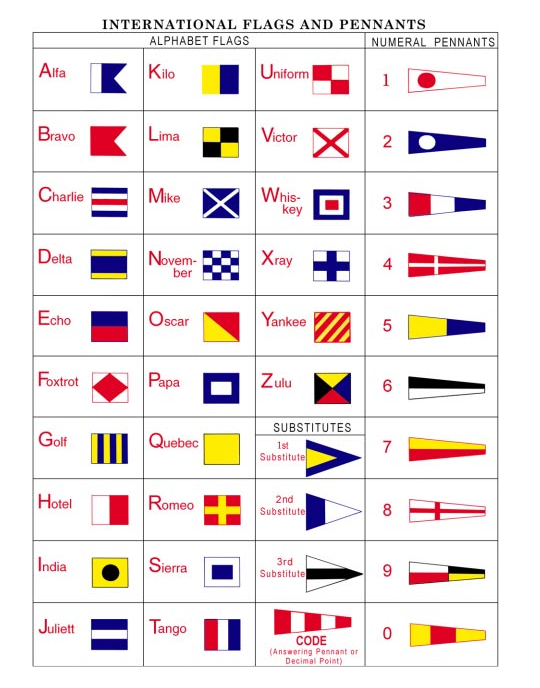Code letters
Code letters or ship's call sign (or callsign)[1][2] were a method of identifying ships before the introduction of modern navigation aids. Later, with the introduction of radio, code letters were also used as radio call signs.
History
In 1857, the
Flags used
Code letters used the twenty-six flags that represent the letters of the alphabet, plus the ten flags that represent the digits 0 - 9 also have been used.[1] The substitute flags have not been used for call signs.

Each flag has own name. If the ship's call sign is "3EJH2" ![]()
![]()
![]()
![]()
![]() (Panama Flag)[1] the seamen never say "Three E J H Two". They say "Three Echo Juliet Hotel Two" to avoid misunderstanding as every country seamen have own pronunciation of letters and during speech over radio letters can be inaudible.
(Panama Flag)[1] the seamen never say "Three E J H Two". They say "Three Echo Juliet Hotel Two" to avoid misunderstanding as every country seamen have own pronunciation of letters and during speech over radio letters can be inaudible.
If call sign has 4 characters, the first character or figure of ship's call signs means country code for the ships registered under this country flag. If call sign has 5 characters, the first two characters or figure plus character of ship's call signs means country code for the ships registered under this country flag. The variations 4 or 5 characters due to 36 characters (26 letters + 10 digits) are not enough for all countries. For or the Soviet Union was used character "U" as the first character in call signs: cargo ship Metallurg Anosov had call sign "USMW" ![]()
![]()
![]()
![]() . In case that the ship changes the flag she has to change call sign also. For example, the ship Heinrich Arp: Code Letters "RDWL" (1923-34)
. In case that the ship changes the flag she has to change call sign also. For example, the ship Heinrich Arp: Code Letters "RDWL" (1923-34) ![]()
![]()
![]()
![]() were changed to Code Letters "DHKV" (1934-45)
were changed to Code Letters "DHKV" (1934-45) ![]()
![]()
![]()
![]() and from 1946 once more to the Soviet Union Ship's call sign (unknown, but first character was "U").
and from 1946 once more to the Soviet Union Ship's call sign (unknown, but first character was "U").
If the ship is scrapped or sunk, usually after a long time her call sign can be given to another ship.
The last three characters of ship's call sign usually mean nothing, but one of them used as a code of the government Shipping Companies if the country has more than one Shipping companies.
Today, each sea-going ship must keep on board the book or computer's play-disk "List of Ship Stations and Maritime Mobile Service Identity Assignments" of
Some canals or narrow places have special requirements for the vessels to hoist their call sign flags during the transit through the area. The Suez Canal was once such place where this requirement was made. Thanks to technological advances in the navigation abilities of marine craft, this action is no longer compulsory.
References

- ^ a b c SHIPSPOTTING.COM >> Mtide Taurus - IMO 7626853
- ^ Call Sign is correct and this abbreviation is mentioned usually in all ship's documents now.
- ^ a b "The allocation and use of ship identification signal codes for merchant ships to WWII". Jeremy Lowe. Retrieved 16 January 2009.
- ^ "Shipping Intelligence". Liverpool Mercury etc. No. 3138. Liverpool. 9 March 1858.
- ^ This website has a transcript of radio communications between MS Hans Hedtoft (OXKA) and FV Johannes Krüss (DEQW).
- ^ "ITU >> "Radio Regulations Articles", Edition of 2012" (PDF). Archived from the original (PDF) on 2017-07-28. Retrieved 2016-06-12.
- ^ ITU >> List of Ship Stations and Maritime Mobile Service Identity Assignments - Description of fields.
